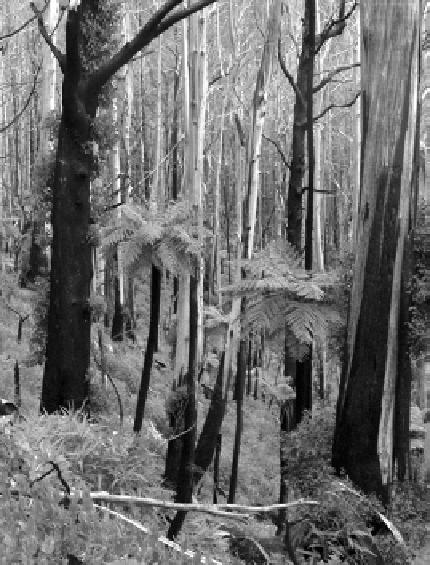Agriculture Reference
In-Depth Information
Fig. 9.4
Tree ferns
(Dicksonia sp.)
with resprouting of apical meristem following high-intensity
crown fire in
Eucalyptus
forest of Victoria, Australia. (Photo by Jon Keeley.)
occurrence in woody dicots, and its presence in Mesozoic gymnosperm lineages
such as
Ephedra
,
Ginkgo biloba
,
Sequoia sempervirens
and
Wollemia nobilis
.
Evidence for resprouting as a fire adaptation is often of the form of plant life
histories consistent with a fire origin, although not mutually exclusive of all other
factors. For example, ferns are a lineage with widespread resprouting in response
to fire, and some lower Cretaceous fern floras appear to have consistently been
associated with fire (Harris
1981
; Scott
2000
). The contemporary
Pteridium
aquilinum
is a worldwide fire-resilient species that resprouts after burning under
a wide range of tropical and temperate habitats (Gliessman
1978
) and there is little
reason to interpret this as an exaptation to some other environmental factor.
Gleichenia
is another taxon that has been associated with fire in Cretaceous
(Herendeen & Skog
1998
), Cenozoic (Collinson
2002
), and Holocene environ-
ments (Black &Mooney
2006
), and resprouts vigorously (Gillison
1969
), as well as
recruiting from spores following fires (Walker & Boneta
1995
). Tree ferns (e.g.
Dicksonia
spp.) persist today in the understory of Australian
Eucalyptus
forests
and survive high-intensity crown fires, with thick overlapping leaf bases protecting
the trunk and allowing postfire resprouting from the apical meristem (
Fig. 9.4
).
The lineage is deeply rooted in the Mesozoic and the widespread existence of fire
evidence from these early forests in association with this and other fern taxa

